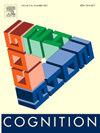词汇意义动态神经模型中语言理解的语境调节
IF 2.8
1区 心理学
Q1 PSYCHOLOGY, EXPERIMENTAL
引用次数: 0
摘要
在动态场理论框架下,对语义动态神经模型的行为预测进行了计算实现和实验验证。我们使用英语词汇项作为测试用例来演示模型的体系结构和行为,重点关注其多义用法。在该模型中,映射到由两个独立驱动的连续概念维度(连通性和控制不对称)定义的语义空间。该映射被建模为表示词法项的神经节点和表示概念维度的神经字段之间的耦合。词汇知识被建模为一种稳定的耦合模式,而实时词汇意义检索被建模为神经激活模式在与语义解释或阅读相对应的短暂稳定状态之间的运动。模型模拟捕获了两个先前报道的经验观察:(1)词汇语义解释的语境调制,(2)这种调制幅度的个体差异。模拟还产生了一个新颖的预测,即句子阅读时间和可接受性之间的关系应该被语境调节。一项结合自定节奏阅读和可接受性判断的实验重复了之前的结果,并部分证实了该模型的新颖预测。总之,这些结果支持了一种关于词汇多义词的新观点:一个词的许多相关意义并不是绝对不同的表征;相反,它们是由控制连续语义维度解释的神经种群的非线性动力学产生的短暂稳定的神经激活状态。与动力系统框架中的相关模型以及基于贝叶斯推理的模型相比,我们的模型具有重要的优势。本文章由计算机程序翻译,如有差异,请以英文原文为准。
Contextual modulation of language comprehension in a dynamic neural model of lexical meaning
We computationally implement and experimentally test the behavioral predictions of a dynamic neural model of lexical meaning in the framework of Dynamic Field Theory. We demonstrate the architecture and behavior of the model using as a test case the English lexical item have, focusing on its polysemous use. In the model, have maps to a semantic space defined by two independently motivated continuous conceptual dimensions, connectedness and control asymmetry. The mapping is modeled as coupling between a neural node representing the lexical item and neural fields representing the conceptual dimensions. While lexical knowledge is modeled as a stable coupling pattern, real-time lexical meaning retrieval is modeled as the motion of neural activation patterns between transiently stable states corresponding to semantic interpretations or readings. Model simulations capture two previously reported empirical observations: (1) contextual modulation of lexical semantic interpretation, and (2) individual variation in the magnitude of this modulation. Simulations also generate a novel prediction that the by-trial relationship between sentence reading time and acceptability should be contextually modulated. An experiment combining self-paced reading and acceptability judgments replicates previous results and partially bears out the model’s novel prediction. Altogether, results support a novel perspective on lexical polysemy: that the many related meanings of a word are not categorically distinct representations; rather, they are transiently stable neural activation states that arise from the nonlinear dynamics of neural populations governing interpretation on continuous semantic dimensions. Our model offers important advantages over related models in the dynamical systems framework, as well as models based on Bayesian inference.
求助全文
通过发布文献求助,成功后即可免费获取论文全文。
去求助
来源期刊

Cognition
PSYCHOLOGY, EXPERIMENTAL-
CiteScore
6.40
自引率
5.90%
发文量
283
期刊介绍:
Cognition is an international journal that publishes theoretical and experimental papers on the study of the mind. It covers a wide variety of subjects concerning all the different aspects of cognition, ranging from biological and experimental studies to formal analysis. Contributions from the fields of psychology, neuroscience, linguistics, computer science, mathematics, ethology and philosophy are welcome in this journal provided that they have some bearing on the functioning of the mind. In addition, the journal serves as a forum for discussion of social and political aspects of cognitive science.
 求助内容:
求助内容: 应助结果提醒方式:
应助结果提醒方式:


